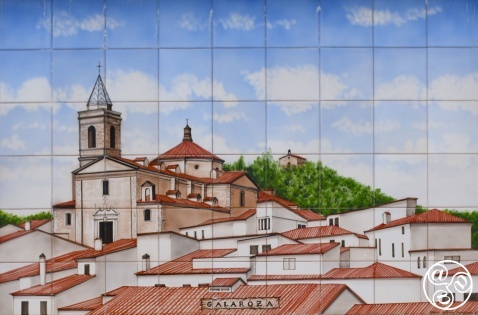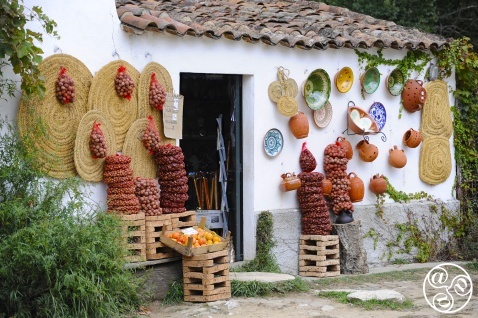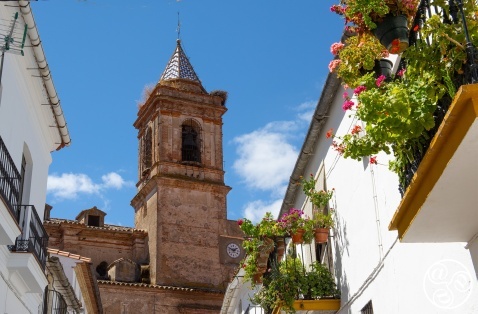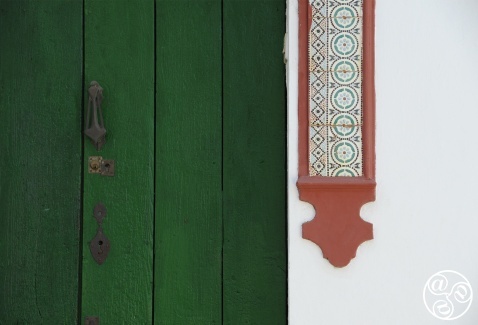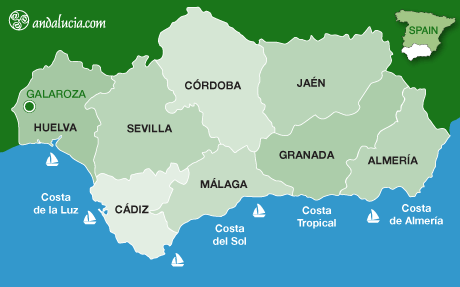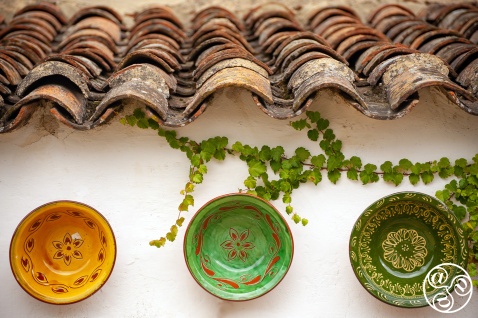
Traditional handmade ceramic plates in Galaroza © Michelle Chaplow |
|
GALAROZA
by Saskia Mier
Galaroza is located within the Parque Natural de la Sierra de Aracena y Picos de Aroche, in the Valle de Murtiga, an area abundant in lush vegetation and thick woodland. The most predominant vegetation is holm and cork oaks, chestnut and pine, perfect for Iberican pigs to root around in.
HISTORY
The have been no traces found that prove the prehistoric existence of inhabitants in Galaroza. Its origin is unclear but seems to be Islamic, since it is assumed that the origin of its name could come from Al-Jaroza which can have different interpretations: Valle de las Rosas (Rose Valley), Valle de las Doncellas(Valley of the Maidens) or Valle de la Desposada (Valley of the Bride). The legend states the Berber Prince Ysmail got lost in the forest as he went in search of a woman in which he was besotted by.
Like the whole region, these lands were occupied by Muslims between the eighth and twelfth centuries. During the thirteenth century it belonged to Portugal and Castille until 1267 when the Treaty of Badajoz signed Galaroza to the Kingdom of Castille.
During the middle ages it belonged to the jurisdiction of Aracena and became independent in 1553. At that time, Galaroza oversaw the villages of Fuente Heridos, Las Vegas, and Las Cañadasy Corte Brullo, as well as Navahermosa and Las Chinas.
In 1594 Galaroza and their villages were part of the Kingdom of Seville in the Sierra de Arroche, until 7 July 1810, when it was taken by the French and occupied until 1812.
THINGS TO SEE
Las Pizarillas
A beautiful religious monument of Galaroza, cared for by the neighbours of the village and today is one of the most photographed village postcards. It is the meeting place during the religious ceremony of Las Cruces de Mayo. Located just behind the Iglesia Parroquial.
Eras Comunales
Galaroza has two ancient threshing plots, very close together and raised on a small hill north east of the village. They possess an undeniable ethnological value and a magnificent view of the village centre. You could say that it is the only threshing plot located within a populated village.
Fuente de los Doce Caños
The fountain of Nuestra Señora del Carmen, popularly known as the Fuente de los Doce Caños (Fountain of the Twelve Spouts), is found in the centre of the village and is filled naturally by a spring that is located at the foot of the hill of Santa Brígida. It was built in 1889 and was paid for by the contribution of the inhabitants. Its construction resembles a drop of water seen from a distance or from above. Located in Plaza de los Alamos.
Iglesia de Nuestra Señora del Rosario
The church is a single rectangular building with transversal arches and a vaulted rectory, dating its construction to the last third of the sixteenth century.In the eighteenth century, the front of the building was built, framed in the second transverse arch, with entrance and steeple decorated with original carved and shaped bricks.Located in the nearby village of Navahermosa.
Ermita de Santa Brígida
A chapel and viewpoint located at the top of a hill overlooking the village with views over the Valle de Múrtigas, El Pico de la Era (between Linares and Los Marines), Cerro de Castaño, El Picote, San Cristobal and to Puerto Lucia.Inside the chapel there is a Churrigueresque altarpiece which contains the image of the Holy Saint. The first section was built in 1846 by Christian settlers and further expansion or reconstruction could have been done by the inhabitants.
Iglesia del Carmen
The church was built under the invocation of San Sebastian for protection against the plague epidemics. The main altar boats a sculpture of the Virgen del Carmen, patroness of Galaroza. Following its recent restoration, it was discovered that it was originally home to Virgin de la Merced in the late sixteenth century. Located in Plaza de los Alamos.
Iglesia Purísima Concepcion
The church was built during the seventeenth century, corroborated not only by documentary sources, but by the inscription on the lintel of the side entrance, 1606; and also the outside wall of the rectory, 1652. Works were made in the eighteenth century to repair the considerable damage by the Lisbon earthquake of 1755. Located at the end of Calle Iglesia.
Hotels in Galaroza
Book Hotels in Galaroza
COUNTRYSIDE WALKS
Galaroza is ideal for lovers of rural tourism, especially hikers, with paths of varying steepness surrounded by beautiful countryside. There are at least 40 routes available in the vicinity; however, popular routes include Galaroza to Jabugo, and El Telenque de Navahermosa, which includes Valdelarco and Telenque Recreational Area.
A variety of flora and fauna can be observed in the area including critically endangered bird species such as the red kite, Egyptian vulture, black stork and the black vulture. Mammals such as the marten, genet, mongoose, deer and wild boar can also be seen.
GASTRONOMY
The gastronomy of Galaroza is based on the Iberian pork, like so many other village sin the Sierra de Aracena. The most popular dish is la caldereta, made from potato, pork liver and pork ribs. Migas made with potatoes, wine, garlic and sardines, as well as wild cepsare also popular.An abundance and variety of fruits, especially peros (apples), chestnuts, peaches, walnuts and cherries are also used in cooking to make desserts. Peaches are dried and used to make orejones.
HANDICRAFTS
Local handicrafts include ceramics and typical Andalucian furniture, such as hand painted rush-matting chairs and tables. Cork pieces and pork products are also available.
FESTIVALS
El Dia del Huevo y El Bollo
Translated literally as 'The Day of the Egg and Bun' where villagers make decorated buns for the occasion. Celebrated on Easter Sunday on the hill of Santa Brigida.
Pirulitos
Celebrated on 24 June, a tree is taken from a field and crowned with an onion and a mirror. It is then decorated with garlands and sung to.
Romeria de la Divina Pastora
A pilgrimage celebrated at the end of May/beginning of June.
Feria del Carmen
Local summer festival lasting a few days at the end of July.
Los Jarritos
Celebrated 6 September, water from the fountain is used to souse everybody in sight.
Belén Viviente
A living nativity scene created by villagers of all ages. Celebrated on Saturdays and Sundays in December and first week of January between 18:30-20:30hrs.
LOCATION
Galaroza is 100 km from Huelva city. Take the A-49, leave at exit 75, towards Trigueros. Then take the N-435 and the N-433 which will take you to Galaroza.
